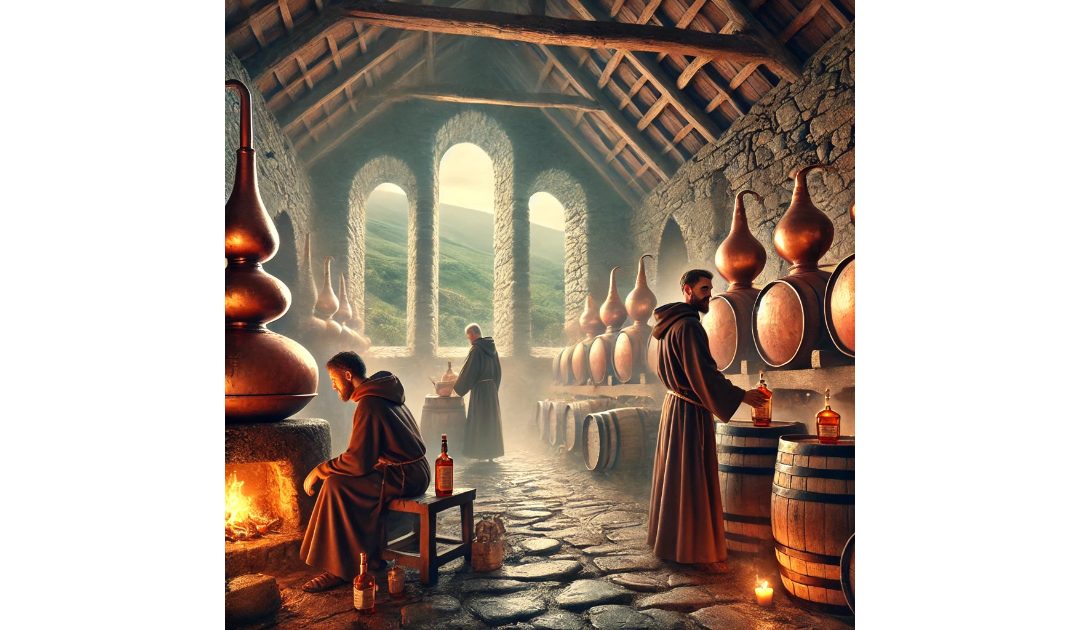On the 1st of June, 1495, a monk by the name of John Cor recorded the first written mention of Scotch whisky. I have posted several times on Mary Queen of Scots and other Scottish historical events and people, but now it is time to discuss the spirit.
Whisky, a distilled alcoholic beverage, holds a revered place in the annals of global drinks. Among the varied types of whisky, Scotch and Irish whiskies stand out with their rich histories, flavours, and production techniques. Though they share a common root, each has carved out its own unique identity over the centuries. Let’s delve into the beginnings of both Scotch and Irish whisky to appreciate how these fine spirits came to be.
The history of Scotch whisky is as misty as the highlands it hails from. It is said that whisky distillation in Scotland began with the arrival of the monks in the 11th century. These monks were skilled in the art of distillation, which they employed primarily for medicinal purposes. The term “whisky” itself is derived from the Gaelic word “uisge beatha,” meaning “water of life.”
The earliest written record of whisky production in Scotland dates back to 1496, involving King James IV’s purchase of malt for Friar John Cor to make aqua vitae. By the 17th century, whisky production had spread widely across Scotland, with each region developing its own distinctive style.
Central to the production of Scotch whisky are the unique ingredients and techniques employed. Made primarily from malted barley, Scotch whisky is known for its smoky flavour, a result of drying the malted barley over peat fires. This method of smoking the grains imparts a distinct and complex character to the whisky.
Scotch whisky is traditionally aged in oak casks for a minimum of three years, a practice that developed over time as distillers realised that whisky improved with age. Today, it is not uncommon for Scotch whisky to be aged for decades, further enhancing its flavour profile.
Irish whisky, like its Scottish counterpart, has a long history steeped in tradition. The origins of whisky in Ireland are similarly linked to monastic distillation practices. As the story goes, Irish monks brought the technique of distilling spirits to Ireland from the Mediterranean around the 6th century.
Ireland’s first documented mention of whisky appears in the Annals of Clonmacnoise, a 1405 chronicle that notes the death of a chieftain after consuming “aqua vitae”. This record underscores the early historical roots of whisky in Ireland.
Unlike Scotch whisky, which prominently features peat-smoked malt, Irish whisky traditionally employs a different technique known as “triple distillation”. This method involves distilling the spirit three times, resulting in a smoother and lighter whisky. Furthermore, Irish whisky often incorporates a mix of malted and unmalted barley, contributing to a more diverse flavour profile.
By the 18th century, Irish whisky was highly regarded and exported across the globe. However, the Irish whisky industry faced several challenges in the 19th and 20th centuries, including competition from Scotch, the Irish War of Independence, and Prohibition in the United States. These setbacks led to a period of decline, but the industry has seen a remarkable resurgence in recent decades, with new distilleries and innovative approaches reviving the spirit.
Though Scotch and Irish whiskies share a common heritage, their development over the centuries has led to distinct differences in production, taste, and tradition. Scotch whisky is renowned for its robust, smoky profile, a testament to its peat-smoking methods and lengthy maturation process. In contrast, Irish whisky is celebrated for its smoothness and lightness, achieved through triple distillation and the use of both malted and unmalted barley.
In conclusion, the stories of Scotch and Irish whiskies are not merely tales of production techniques but narratives of cultural identity, resilience, and innovation. Whether you prefer the smoky allure of Scotch or the smooth elegance of Irish whisky, each sip connects you to a vibrant history that dates back centuries.

